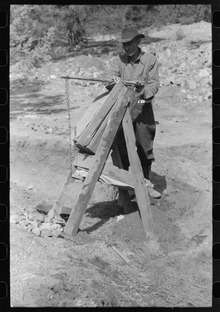Drywasher

A drywasher is a common desert mining tool for gold mining.
A drywasher is like a highbanker, since it uses a motor and a form of sluice, but it has no need for water. It drywasher operates by the use of air.[1] By forcing air to flow up through the material as it moves down the sluice, the heavier materials, like gold, will stay at the bottom and get trapped by the riffles while the lighter materials will flow up and over the riffles or be blown away. The lighter material that is not blown away will slowly flow down the sluice and fall out the end of the sluice.
Drywasher - A mechanical apparatus used for separating free particles of placer gold from dry sediments. Dry placers represent a major portion of all alluvial gold deposits around the globe. Extreme aridity in southern hemispheric regions of the planet causes a slower rate of erosion on placer deposits than if rainfall were plentiful and regional watersheds were hydrologically active. This absence of water directly correlates to the low moisture content of alluvial sediments and the short distance gold moves from its hardrock source. A drywasher works on the principle of gravity separation. Since gold, at 19.1 specific gravity, is much heavier than most other minerals found in local sediments, a facsimile of certain natural conditions (which would involve the use of water, if it were available) can be mechanically reproduced with a simple machine using dry air instead of water as the medium of separation. The process of excavating dry, compacted sediments will often loosen or unconsolidate them. Then, as long as the material is sufficiently dry, these gravels can be processed with a drywasher in a relatively efficient manner.
A drywasher was also known, at one time, as a Mexican air jig. To use a drywasher, first, one must determine if the raw material is dry enough to be efficiently processed. Once the machine is set up and stabilized, using a shovel, the dirt, clay, sand, gravel, etc. is loaded onto the uppermost part of the device — the screen, or "grizzly". Sediments classified by the grizzly, drop into another part of the apparatus known as "the hopper". Once the machine is activated, the finer, gold-bearing material travels down an inclined, vibrating chute, passing over a series of "riffles" in a recovery tray. This process varies slightly from machine to machine. Heavier minerals, principally gold and fine-grained black sands (various iron minerals), are separated from the paydirt and reconcentrated by this means. Panning, or some other final separation process, comes afterwards.
The first machines were, in all likelihood, operated manually. A simple one can be constructed using a wooden framework, a hopper, a recovery tray, bellows, lever, and cord. Before the advent of modern metal screening material, sorting of gravels into smaller particles might have been done by hand. Such elimination of larger rocks aids in separating gold from dry, auriferous sediments to be processed, consequently, any modern "puffer-belly" could be outfitted with a screen, or "grizzly" for sorting the dry gravels into two sizes.
On Dec 11 1877, a novice miner, William Gibson Guthrie (b.1853 Scotland, presumed d.1878 Arizona) wrote from Prescott, Arizona Territory, back to his brother in England about his proposed venture using the new machine for dry wash mining. This dates the invention of dry wash mining to 1877 or just before. The relevant extract from his letter reads:
“Well, I am going down into Southern Arizona to ? a new process called dry washing. That is working without water. I have great hopes of this speculation, that is if we can get ground that will pay, which I think we can. The machine works to perfection.
It is no use explaining the machine or how much can be made per day – that depends on the ground we get.
It will cost 600 or 700 dollars between us. I expect to get started in a week or two if everything goes well. I don’t want to say too much about it until we get to the scene of the operation.”
William entered into this venture with a partner, hence the mention of “600 or 700 dollars between us”. Unfortunately this is the last anyone ever heard from William and he simply disappeared from record. He is presumed to have died in Arizona in 1878, aged 24 or 25.
SOURCE: Original family letter kept by its recipient and passed to his heirs. For the sake of complete accuracy it is best to point out that the quote above is taken from a transcript of the original letter, which may or may not still exist. There is no reason to doubt its authenticity.
References
- ↑ "Dry Washers for Gold". Retrieved 13 June 2013.
- Smith, Alfred Merritt; Vanderburg, Wm. O. (15 December 1932), "Placer Mining in Nevada", University of Nevada Bulletin, University of Nevada, Reno, [Nevada State Bureau of Mines], 36 (8): 31–35.
- West, J. M. (1971), How to Mine and Prospect for Placer Gold, Information Circular 8517, Bureau of Mines. Date unknown. Republished in electronic format with foreword by the ICMJ's Prospecting and Mining Journal.
